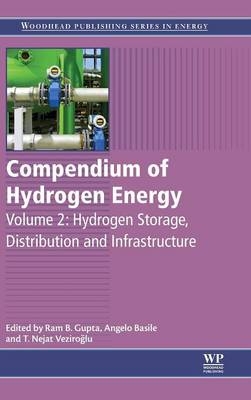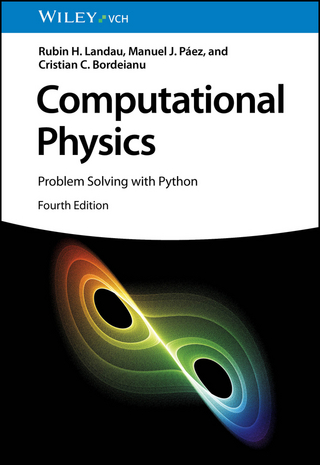
Compendium of Hydrogen Energy
Woodhead Publishing Ltd (Verlag)
978-1-78242-362-1 (ISBN)
Other sections in the book explore physical and chemical storage, including environmentally sustainable methods of hydrogen production from water, with final chapters dedicated to hydrogen distribution and infrastructure.
Dr. Ram Gupta is an Associate Professor of Chemistry at Pittsburg State University. He is the Director of Research at the National Institute for Materials Advancement (NIMA). Dr. Gupta has been recently named by Stanford University as being among the top 2% of research scientists worldwide. Before joining Pittsburg State University, he worked as an Assistant Research Professor at Missouri State University, Springfield, MO then as a Senior Research Scientist at North Carolina A&T State University, Greensboro, NC. Dr. Gupta’s research spans a range of subjects critical to current and future societal needs including: semiconducting materials & devices, biopolymers, flame-retardant polymers, green energy production & storage using nanostructured materials & conducting polymers, electrocatalysts, optoelectronics & photovoltaics devices, organic-inorganic heterojunctions for sensors, nanomagnetism, biocompatible nanofibers for tissue regeneration, scaffold & antibacterial applications, and bio-degradable metallic implants. Angelo Basile, a Chemical Engineer, is a senior Researcher at the ITM-CNR, University of Calabria, where he is responsible for research related to both the ultra-pure hydrogen production and CO2 capture using Pd-based Membrane Reactors. Angelo Basile's h-index is 53, with 387 document results with a total of 8,910 citations in 5,034 documents (www.scopus.com – 24 May 2023). He has more than 170 scientific papers in peer-to-peer journals and 252 papers in international congresses; and is a reviewer for 165 int. journals, an editor/author of more than 50 scientific books and 120 chapters on international books on membrane science and technology; 6 Italian patents, 2 European patents and 5 worldwide patents. He is referee of 104 international scientific journals and Member of the Editorial Board of 22 of them. Basile is also Editor associate of the Int. J. Hydrogen Energy and Editor-in-chief of the Int. J. Membrane Science & Technol. and Editor-in-chief of Membrane Processes (Applications), a section of the Intl J. Membranes. Basile also prepared 42 special issues on membrane science and technology for many international journals (IJHE, Chem Eng. J., Cat. Today, etc.). He participated to and was/is responsible of many national and international projects on membrane reactors and membrane science. Basile served as Director of the ITM-CNR during the period Dec. 2008 – May 2009. In the last years, he was tutor of 30 Thesis for master and Ph.D. students at the Chemical Engineering Department of the University of Calabria (Italy). From 2014, Basile is Full Professor of Chemical Engineering Processes. Dr. Veziroglu, a native of Turkey, graduated from the City and Guilds College, the Imperial College of Science and Technology, University of London, with degrees in Mechanical Engineering (A.C.G.I., B.Sc.), Advanced Studies in Engineering (D.I.C.) and Heat Transfer (Ph.D.). In 1962 – after doing his military service in the Ordnance Section, serving in some Turkish government agencies and heading a private company – Dr. Veziroglu joined the University of Miami Engineering Faculty. In 1965, he became the Director of Graduate Studies and initiated the first Ph.D. Program in the School of Engineering and Architecture. He served as Chairman of the Department of Mechanical Engineering 1971 through 1975, in 1973 established the Clean Energy Research Institute, and was the Associate Dean for Research 1975 through 1979. He took a three years Leave of Absence (2004 through 2007) and founded UNIDO-ICHET (United Nations Industrial Development Organization – International Centre for Hydrogen Energy Technologies) in Istanbul, Turkey. On 15 May 2009, he attained the status of Professor Emeritus at the University of Miami. Dr. Veziroglu organized the first major conference on Hydrogen Energy: The Hydrogen Economy Miami Energy (THEME) Conference, Miami Beach, 18-20 March 1974. At the opening of this conference, Dr. Veziroglu proposed the Hydrogen Energy System as a permanent solution for the depletion of the fossil fuels and the environmental problems caused by their utilization. Soon after, the International Association for Hydrogen Energy (IAHE) was established, and Dr. Veziroglu was elected president. As President of IAHE, in 1976 he initiated the biennial World Hydrogen Energy Conferences (WHECs), and in 2005 the biennial World Hydrogen Technologies Conventions (WHTCs). In 1976, Dr. Veziroglu started publication of the International Journal of Hydrogen Energy (IJHE) as its Founding Editor-in-Chief, in order to publish and disseminate Hydrogen Energy related research and development results from around the world. IJHE has continuously grew; now it publishes twenty-four issues a year. He has published some 350 papers and scientific reports, edited 160 volumes of books and proceedings, and has co-authored the book “Solar Hydrogen Energy: The Power to Save the Earth. Dr. Veziroglu has memberships in eighteen scientific organizations, has been elected to the Grade of Fellow in the British Institution of Mechanical Engineers, American Society of Mechanical Engineers and the American Association for the Advancement of Science, and is the Founding President of the International Association for Hydrogen Energy. Dr. Veziroglu has been the recipient of several international awards. He was presented the Turkish Presidential Science Award in 1974, made an Honorary Professor in Xian Jiaotong University of China in 1981, awarded the I. V. Kurchatov Medal by the Kurchatov Institute of Atomic Energy of U.S.S.R. in 1982, the Energy for Mankind Award by the Global Energy Society in 1986, and elected to the Argentinean Academy of Sciences in 1988. In 2000, he was nominated for Nobel Prize in Economics, for conceiving the Hydrogen Economy and striving towards its establishment.
List of contributors
Part One: Hydrogen storage in pure form
1: Introduction to hydrogen storage
Abstract
1.1 Introduction
1.2 Physical storage
1.3 Material-based hydrogen storage
2: Hydrogen liquefaction and liquid hydrogen storage
Abstract
Acknowledgments
2.1 Introduction: Why liquefying hydrogen?
2.2 Basics of cryogenic liquefaction
2.3 Hydrogen thermodynamic properties at ambient and low temperatures
2.4 Large-scale hydrogen liquefaction and storage
2.5 Advantages and disadvantages
2.6 Current uses of liquid hydrogen
2.7 Sources of further information and advice
3: Slush hydrogen production, storage, and transportation
Abstract
3.1 Introduction: What is slush hydrogen?
3.2 Hydrogen energy system using slush hydrogen
3.3 Thermophysical properties of slush hydrogen
3.4 Process of producing and storing slush hydrogen
3.5 Density and mass flow meters for slush hydrogen
3.6 Advantages and disadvantages of transporting slush hydrogen via pipeline
3.7 Uses of stored slush and liquid hydrogen
3.8 Conclusions
3.9 Future trends
3.10 Sources of future information and advice
Appendix A Production
Appendix B Flow and heat transfer
Appendix C Measurement instrumentation
4: Underground and pipeline hydrogen storage
Abstract
Acknowledgments
4.1 Underground hydrogen storage as an element of energy cycle
4.2 Scientific problems related to UHS
4.3 Biochemical transformations of underground hydrogen
4.4 Hydrodynamic losses of H2 in UHS
4.5 Other problems
4.6 Pipeline storage of hydrogen
Part Two: Physical and chemical storage of hydrogen
5: Cryo-compressed hydrogen storage
Abstract
Acknowledgments
5.1 Introduction
5.2 Thermodynamics and kinetics of cryo-compressed hydrogen storage
5.3 Performance of onboard storage system
5.4 Well-to-tank efficiency
5.5 Assessment of cryo-compressed hydrogen storage and outlook
6: Adsorption of hydrogen on carbon nanostructure
Abstract
6.1 Introduction
6.2 General considerations for physisorption of hydrogen on carbon nanostructures
6.3 Carbon nanotubes and fullerenes
6.4 Activated carbons
6.5 Layered graphene nanostructures
6.6 Zeolite-templated carbons
6.7 Conclusion
7: Metal–organic frameworks for hydrogen storage
Abstract
7.1 Introduction
7.2 Synthetic considerations
7.3 Cryo-temperature hydrogen storage at low and high pressures
7.4 Room temperature hydrogen storage at high pressure
7.5 Nanoconfinement of chemical hydrides in MOFs
7.6 Conclusions and future trends
8: Other methods for the physical storage of hydrogen
Abstract
8.1 Introduction
8.2 Storage of compressed hydrogen in glass microcontainers
8.3 Hydrogen physisorption in porous materials
8.4 Hydrogen hydrate clathrates
8.5 Conclusions and outlook
9: Use of carbohydrates for hydrogen storage
Abstract
9.1 Introduction
9.2 Converting carbohydrates to hydrogen by SyPaB
9.3 Challenges of carbohydrates as hydrogen storage and respective solutions
9.4 Future carbohydrate-to-hydrogen systems
9.5 Conclusions
9.6 Sources of future information and advice
10: Conceptual density functional theory (DFT) approach to all-metal aromaticity and hydrogen storage
Abstract
Acknowledgments
10.1 Introduction
10.2 Background of conceptual DFT
10.3 All-metal aromaticity
10.4 Role of aromaticity in hydrogen storage
10.5 Case studies of possible hydrogen-storage materials with the aid of CDFT
10.6 Future trends
Part Three: Hydrogen distribution and infrastructure
11: Introduction to hydrogen transportation
Abstract
11.1 Introduction
11.2 Overview of methods for hydrogen transportation
11.3 Difficulties involved with the transportation of hydrogen
11.4 Future trends
11.5 Sources of further information and advice
12: Hydrogen transportation by pipelines
Abstract
12.1 Introduction
12.2 Current hydrogen pipelines
12.3 Principles of transportation of hydrogen
12.4 Gas transportation principles
12.5 Pipeline transportation of hydrogen gas
12.6 Conclusion
12.7 Future trends
12.8 Further reading
13: Progress in hydrogen energy infrastructure development—addressing technical and institutional barriers
Abstract
Acknowledgments
13.1 Introduction
13.2 Recent progress in hydrogen infrastructure in the United States
13.3 Recent progress in hydrogen infrastructure and fuel cell vehicle and fuel cell bus demonstrations in China
13.4 Conclusions
14: Designing optimal infrastructures for delivering hydrogen to consumers
Abstract
Acknowledgments
14.1 Introduction
14.2 Building blocks of hydrogen infrastructure
14.3 Review of hydrogen infrastructure models
14.4 Case study: Decarbonizing UK transport demand with hydrogen vehicles
14.5 Results
14.6 Conclusions
Appendix
15: Investment in the infrastructure for hydrogen passenger cars—New hype or reality?
Abstract
15.1 Introduction
15.2 Uncertainties surrounding the investment in hydrogen infrastructure
15.3 Implementation of the early infrastructure: case studies
15.4 Future trends
15.5 Conclusions
15.6 Sources of further information and advice
Index
| Reihe/Serie | Woodhead Publishing Series in Energy |
|---|---|
| Verlagsort | Cambridge |
| Sprache | englisch |
| Maße | 152 x 229 mm |
| Gewicht | 580 g |
| Themenwelt | Naturwissenschaften ► Physik / Astronomie |
| Technik ► Elektrotechnik / Energietechnik | |
| ISBN-10 | 1-78242-362-1 / 1782423621 |
| ISBN-13 | 978-1-78242-362-1 / 9781782423621 |
| Zustand | Neuware |
| Haben Sie eine Frage zum Produkt? |
aus dem Bereich


